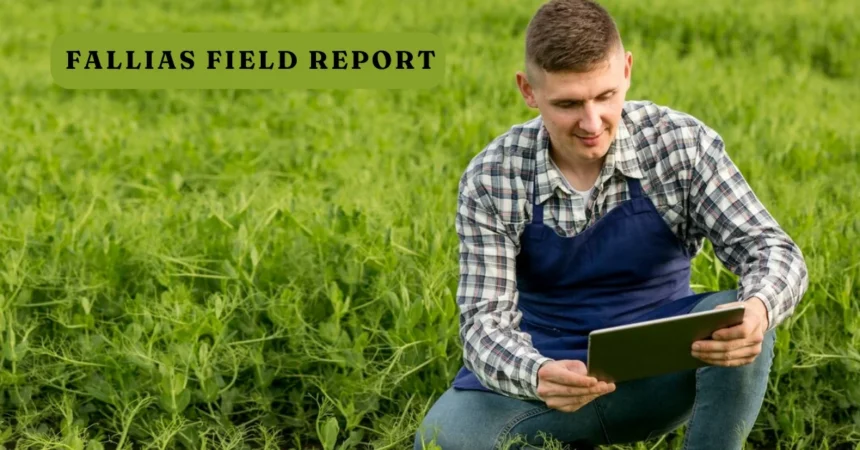Introduction to the Fallias Field Report
The Fallias Field Report stands as a pivotal resource for professionals across various industries. Whether you’re an entrepreneur looking to enhance your business strategy or a researcher aiming to gather insightful data, this report has something valuable to offer. Its comprehensive nature combines historical context with practical applications, making it an essential tool in today’s fast-paced environment. As we dive deeper into the intricacies of the Fallias Field Report, you’ll discover how its structured approach can lead to tangible benefits and improved outcomes. Ready to unlock the insights that could transform your work? Let’s explore what makes this report a must-have in your toolkit.
History and Purpose of the Fallias Field Report
The Fallias Field Report emerged in the early 2000s as a response to growing challenges in data collection and analysis. It was designed to provide clear insights into field operations, particularly in environmental studies and resource management.
With its roots in academic research, the report aimed to bridge gaps between theory and practice. Researchers recognized that accessible information could significantly enhance decision-making processes.
Over time, it evolved into a comprehensive tool for various sectors. Organizations began using it not only for compliance but also for strategic planning.
Its purpose extends beyond mere reporting; it seeks to foster collaboration among stakeholders. By presenting findings clearly, the Fallias Field Report allows teams to align their goals effectively.
Understanding the Structure of the Report
The Fallias Field Report is meticulously structured to enhance clarity and usability. Each section serves a distinct purpose, allowing readers to navigate the content easily.
Typically, it begins with an executive summary. This succinct overview captures key findings and recommendations at a glance.
Following that, background information establishes context. It outlines the objectives of the report while framing its significance within broader industry trends.
Next come the main body sections, where data analysis takes center stage. Here you’ll find charts, graphs, and detailed breakdowns that support each conclusion drawn.
Appendices and references provide additional resources for deeper exploration. These elements are invaluable for those looking to validate the report’s insights or seek further information on specific topics related to their interests or needs.
Key Components of the Fallias Field Report
The Fallias Field Report is structured to deliver insights effectively. Each section serves a distinct purpose, enhancing the overall clarity.
One key component is the introduction. It sets the stage by outlining objectives and scope. This part grabs attention and defines what to expect.
Next comes the methodology section. Here, researchers explain their approach in detail, promoting transparency. This fosters trust among readers about data collection techniques.
Data analysis follows, presenting findings through charts or graphs for easy comprehension. Visual aids play a vital role in interpreting complex information quickly.
Recommendations are another crucial element of the report. These actionable steps guide stakeholders toward implementing effective strategies based on research outcomes.
There’s an evaluation segment that assesses potential challenges and solutions. Addressing foreseeable issues ensures that users can navigate obstacles confidently while applying insights from the report.
Benefits of Using the Fallias Field Report
The Fallias Field Report offers numerous advantages for various stakeholders. Its structured analysis provides clear insights into complex data, making it easier to understand trends and patterns.
By utilizing this report, organizations can make informed decisions that drive efficiency and productivity. The actionable recommendations empower teams to implement strategies that align with their goals.
Furthermore, the collaborative nature of the report encourages communication among departments. This fosters a culture of transparency and accountability within an organization.
Another significant benefit lies in its adaptability. Whether you’re in finance, marketing or operations, the Fallias Field Report can be tailored to suit different needs.
Employing this tool not only enhances operational effectiveness but also positions your organization as forward-thinking and responsive to change. It’s about harnessing knowledge for sustainable growth—an essential factor in today’s competitive landscape.
How to Effectively Implement the Recommendations from the Report
Implementing the recommendations from the Fallias Field Report requires a strategic approach. Start by prioritizing suggestions based on your organization’s immediate needs and long-term goals.
Assign specific team members to oversee each recommendation. This creates accountability and ensures that tasks are executed efficiently. Regular check-ins foster communication, allowing for adjustments if challenges arise.
Consider integrating technology tools that align with the report’s insights. These can streamline processes and enhance productivity across departments.
Training is crucial; equip your staff with necessary skills through workshops or online courses tailored to the report’s findings. Empowered employees will drive successful implementation.
Track progress using measurable metrics. This allows you to evaluate effectiveness continuously and make informed decisions about future actions based on real data.
Real-Life Examples of Success with the Fallias Field Report
Many organizations have harnessed the power of the Fallias Field Report to transform their operations. For instance, a mid-sized tech company used insights from the report to refine its product development process. This led to a 30% reduction in time-to-market for new features.
Another example comes from an educational institution that implemented recommendations on student engagement strategies found within the report. As a result, they saw improved retention rates and enhanced academic performance among students.
A nonprofit organization adopted key elements of the Fallias Field Report to streamline its fundraising efforts. By focusing on targeted outreach, they doubled their donor base in just one year.
These real-world applications underscore how versatile and impactful the Fallias Field Report can be across various sectors. Each success story highlights different aspects of implementation tailored to specific industry needs.
Common Mistakes to Avoid when Utilizing the Fallias Field Report
When utilizing the Fallias Field Report, one of the most common mistakes is misinterpreting data. Always ensure you fully understand the context in which findings were made before drawing your conclusions.
Another frequent pitfall is neglecting to customize recommendations for your specific situation. The report offers a framework, but it’s crucial to tailor strategies to fit unique circumstances.
Failing to engage stakeholders can also lead to ineffective implementation. Keep communication channels open and involve team members early on.
Overlooking follow-up assessments diminishes long-term benefits. Regularly revisit the report’s insights and adjust tactics as needed based on new developments or feedback from your team.
Conclusion: Taking Your
Understanding the Fallias Field Report can transform your approach to various projects and initiatives. By embracing its rich history and structured format, you empower yourself with valuable insights that drive effective decision-making.
The report serves as a roadmap, guiding users through its key components while highlighting the benefits of implementation. Real-life success stories demonstrate its practical applications, reinforcing the effectiveness of following its recommendations.
However, it is crucial to navigate this tool wisely. Avoid common pitfalls by staying informed and adaptable in your application strategy.
Taking your understanding of the Fallias Field Report to new heights opens doors to innovation and growth in any organization or project you’re involved in. Stay curious and engaged; there’s always more to learn from this powerful resource.






